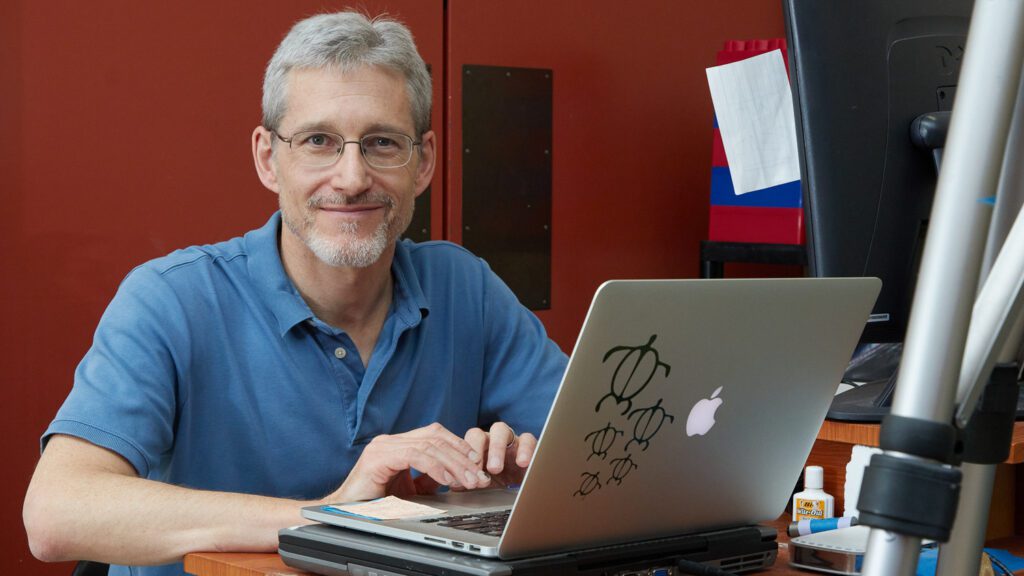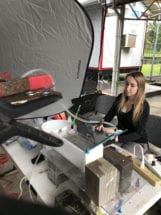Nature is a demanding place to live.
For species to survive, animals must secure food, avoid being eaten themselves and withstand physical and physiological pressures from their environment to live long enough to reproduce.
A group of Clemson University biologists has been studying the biomechanics of waterfall-climbing goby fishes inhabiting oceanic islands as part of an effort to understand how organisms evolve and adapt to survive.
Their research could help humans develop better suction cups.

Learning from nature
“It really comes full circle,” said Rick Blob, alumni professor in the Clemson Department of Biological Sciences, whose lab has been studying the waterfall climbing fish for more than 20 years. “We’re learning from nature and gaining insights about how nature works and how we can help nature persist. But, at the same time, nature is teaching us things we might want to do to help ourselves.”
There are more than 1,000 species of goby fishes. Most live their lives in the ocean, but some are amphidromous and live part of their lives in the freshwater streams of circumtropical oceanic islands.
Those adults live and spawn in freshwater. Upon hatching, larvae are swept downstream to nearshore or ocean habitats. The juveniles live and grow there for up to 10 months before returning to freshwater and breeding habitats further upstream, where they can live and breed for several years.
The journey exposes the gobies, which are usually less than four inches long when fully grown, to various challenges, from evading predators to climbing large waterfalls that are hundreds of meters tall.
“A rough comparison would be a human running a marathon uphill with someone blasting a fire hose at them,” Blob said.
Biomechanics
The researchers use biomechanics to understand how animals perform tasks that are important for their survival. Those tasks are often at odds with each other. In amphidromous gobies, the functions of predator escape and climbing can impose conflicting demands.

“Being really good at one of those jobs might make you bad at the other one, and that might ultimately lead to failure or extinction if you’re too overly specialized,” Blob said. “One theme of our work is what can we observe in these species that lets us understand how they’ve managed to deal with both of these important jobs.”
Another theme of the lab’s research is how a novel ability emerges in a group of organisms.
Climbing waterfalls is a relatively new skill. Amphidromous gobies have two styles of climbing.
Power burst climbers use a suction cup on their bellies to wildly move up the rock quickly and then rest. Inching climbers have the belly suction cup, too, but they also use their mouth to form another suction cup to move slowly and steadily up the rock, said Amanda Palecek, a Ph.D. student in Blob’s lab and a co-author of a paper in a recent special issue of the Journal of Experimental Biology that reviewed and synthesized the Blob lab’s two decades of waterfall-climbing goby fish research.
More than one way
“One of the things our research has shown is that there’s actually more than one way to solve a problem. The formal name for this is ‘many-to-one mapping,’ where you have many possible arrangements of the anatomy of the animal — which parts of the body do particular functions — and when you put all those different puzzle pieces together, you still end up with success at the end,” Blob said. “The different styles of climbing are a great example.”

Palecek said the goby’s climbing behavior could have originated from the fish scraping food off rocks. If the rock was vertical instead of horizontal, the fish would have to move vertically to reach it, thus “climbing” the rock.
“Some of these things that seem new and really radical in many cases are something they were already doing. They’re just making it work for a different purpose,” Blob said.
Palecek said she would love to apply what she’s learned about gobies to improve manmade adhesives.
“I’m a big fan of biomimicry — which is taking a trait in nature and applying it to human technology and design. I think everybody has had experience with a really bad suction cup that won’t stick to things after a while,” she said. “Gobies aren’t sticking to really clean, indoor surfaces. They are sticking to dirty, wet and algae-covered surfaces. And they’re able to stick and re-stick. I think the field of adhesives would really benefit from learning more about these fishes and some other species that use similar adhesive structures, such as octopuses.”
Better adhesives
Palecek said if we’re able to make adhesives that work on really challenging surfaces such as human skin or the underside of a boat, or on rough surfaces like brick, society would benefit.
“The problems that these fish have evolved to solve are things that we still struggle with as engineers. It’s a great opportunity to learn from them to figure out better solutions,” Blob said.
Detailed findings from the lab’s research can be found in the paper titled “Integrating biomechanics in evolutionary studies, with examples from the amphidromous goby model system” that appeared in the journal’s “A Century of Comparative Biomechanics: Emerging and Historical Perspectives on an Interdisciplinary Field” issue.
In addition to Blob and Palecek, the paper’s co-authors include three Clemson Ph.D. graduates: Kelly Diamond, Takashi Maie and Kristine Moody. Diamond is now an assistant professor of biology at Rhodes College in Memphis, Tennessee. Maie is an assistant professor of biology at St. Olaf College in Northfield, Minnesota. Moody is a research scientist at Oak Ridge National Laboratory.
Get in touch and we will connect you with the author or another expert.
Or email us at news@clemson.edu
